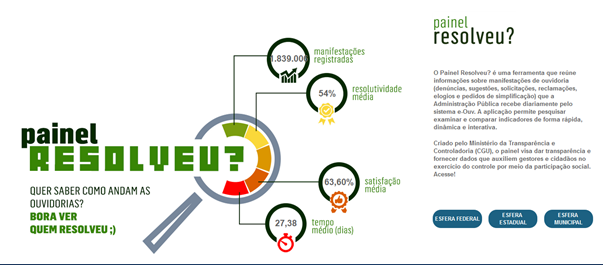Public Ouvidorias in Brazil: From Accounting to Multifaceted Accountability
Versão em português: Ouvidorias públicas no Brasil: do controle contábil-financeiro ao controle social
The word ouvidoria is a neologism, or a new word formed of the verb ouvir (to listen), meaning that ouvidorias are state agencies meant to listen to citizens and translate their desires, anxieties, and complaints into public policy. Ouvidorias, which are roughly translated as Ombudsman, are subdivisions of public agencies responsible for intermediating citizen-state communication. Ideally, ouvidorias are responsible for capturing individual citizens’ grievances, analyzing them and turning them into policy inputs. Ouvidorias therefore aim at providing citizens with an institutional channel that allows them to interact with policy-makers at a microlevel, therefore enabling civic participation more broadly, more systematically and more often than if such participation were limited to elections. Despite representing the idea of a democratic, bottom-up approach to accountability, ouvidorias’ role in Brazil’s accountability system remains limited due to their dependency vis-à-vis the institution to which they belong and to their lack of “teeth” to enforce their recommendations. Ouvidorias aim at increasing government porosity to public demands; however, they still lack real power to carry out such promise, and they therefore risk being captured by public officials merely interested in creating a façade to legitimize their actions.
Despite representing the idea of a democratic, bottom-up approach to accountability, ouvidorias’ role in Brazil’s accountability system remains limited due to their dependency vis-à-vis the institution to which they belong and to their lack of “teeth” to enforce their recommendations. Ouvidorias aim at increasing government porosity to public demands; however, they still lack real power to carry out such promise, and they therefore risk being captured by public officials merely interested in creating a façade to legitimize their actions.
Ouvidorias have spread through Brazilian institutions over the past few decades. Brazil’s 1988 democratic Constitution did not expressly mention ouvidorias, but it did contain a provision that stated that future legislation must regulate citizen participation in public policy, especially through grievance redressing mechanisms (art. 37, §3º, Brazilian Constitution). Based on this constitutional provision, state agencies began to create strategies designed to fulfill this constitutional promise, and the ouvidorias have become perhaps the most common mechanism of addressing such promise.
However, during the 1990s and the 2000s state agencies created and further developed ouvidorias in a highly decentralized fashion, with no uniform national legislation to conduct the process. Said differently, the thousands of public agencies in Brazil (if we consider agencies at the federal, state and municipal levels) developed their own, mostly uncoordinated strategies to enhance public participation in policy making. The outcome of that was that ouvidorias vary widely in terms of structure and effectiveness depending on which public agency they are located. The federal executive government alone is composed of more than 300 agencies, each with its own ouvidoria; Brazil’s 26 states and 5,500 municipalities each contain their own range of public agencies and correspondent ouvidorias. For instance, the ouvidoria of the Universal Health System (Sistema Único de Saúde – SUS) has a huge infrastructure and receives and responds to thousands of citizens complaints per day. This stands in contrast with smaller agencies that rarely interact with the public and have therefore ouvidorias composed of only one or two public officials, with no real structure, resources or power. More importantly, ouvidorias interact mainly with the heads of their own agencies, and not as much with other ouvidorias or other agencies.
This scenario of lack of coordination began to change with the passing of the Freedom of Information law in 2011 (Law n. 12.527/2011). For the first time, all public agencies of all levels of government were attributed one common duty: upon request, they had to disclose, within 30 days, public information held by them. Most agencies that had ouvidorias relied on them to coordinate and deliver this new right. For the first time, Brazilian institutions (especially within the federal government) began to develop a more coordinated strategy to interact with citizens. The creation in 2012 of a unified electronic portal (E-Sic) to receive such information requests, combined with the legal establishment of a unified procedure for responding to information requests, was an important mark in this coordination effort. This allowed ouvidoriais to “speak the same language”, at least in terms of following the same procedures for responding to public information requests.
This process of coordination and centralization of information was led by the Ouvidoria-Geral da União (OGU), or General Ombudsman Office, a subdivision within the Office of the Comptroller General whose main responsibility was to promote centralized strategies of enhancing public participation. The General Ombudsman Office began to manage the electronic portal E-Sic after the Freedom of Information Law of 2011 made its adoption compulsory for all agencies within the federal government. This allowed the General Ombudsman to centralize information regarding ouvidorias’ activities throughout the federal branch of government.
After the implementation of the Freedom of Information Law, the General Ombudsman Office began to informally broaden the range of its institutional authority. It aimed at centralizing information about all of the activities performed by the ouvidorias – not only access to information. In 2014 it created a second electronic portal, which mirrored the E-Sic but received different kinds of citizens requests: grievances, complaints, denunciations and compliments. This second system was called E-ouv – electronic system of ouvidorias, and was merged with the former E-Sic in 2019. [1]
Along with this informal power of coordinating and centralizing information about all ouvidorias within the executive federal branch, the General Ombudsman Office actively supported legislation and regulation that would formalize and strengthen its power. After a 2013 decision by the Supreme Court that ordered the federal government to pass legislation to regulate article 37, §3º of the Constitution,[2] federal agencies began to draft a new law, which would be approved in 2017 and would be called the “Public Service Users Protection Law” (Law n. 13.460/17). This was the first piece of legislation that would expressly regulate the ouvidoriais. The law did not provide a definition of what a ouvidoria unit is, but it did outline its goals: (i) to promote citizen participation in public administration; (ii) to monitor service delivery within the public sector; (iii) to propose improvements to public services; (iv) to assist public agencies in identifying irregularities within public service delivery; (v) to propose administrative initiatives aimed at defending public service users; (vi) to receive, analyze and give notice to public authorities of any kind of citizen grievance received through its channels; (vii) to promote conciliation and mediation in conflicts between citizens and public agencies (art. 13, Law n. 13.460/2017).[3] The law also stated that, in order to achieve such goals, ouvidorias should, at a minimum, reactively receive citizens’ grievances and proactively collect data regarding citizen satisfaction (or dissatisfaction) with government performance, as well as elaborate an annual service report in which it would incorporate all information gathered regarding public service implementation (art. 14, Law n. 13,460/2017).
The ongoing strengthening of public ouvidorias in Brazil can be interpreted as an honest attempt by public agencies and legislators to promote more inclusivity and participation in service delivery. From a theoretical standpoint, they are innovative for having created a downwards form of accountability. This represents a transition from the idea of “control” in terms of a top-down, authoritarian, narrow approach to financial auditing to multi-faceted, broader and more public oversight policies that include public input and are therefore more aligned with democratic goals. Ouvidorias have undeniably constituted themselves as oversight institutions. Yet they do not carry out traditional financial, budgetary, or accounting audits. Their role is more associated with the idea of “social oversight,” (or “social control”) which has been consolidated in Brazilian vocabulary and practice. Social oversight incorporates a genuinely democratic face of control, that is, an attempt to incorporate the legitimacy of public acts and their adherence to the public’s concerns – a conception of oversight that goes beyond economic or administrative efficiency.
Nevertheless, ouvidorias face some major challenges moving forward, and it seems unlikely that such institutions can overcome them in the near future.
A first major challenge is the complexity of Brazil’s administrative state. The federal government alone provides more than 4,000 different services [4]– in this scenario, communicating with the public about their rights and how to access them is a major challenge. So is keeping track of the quality of services implemented. Ouvidorias are meant to bridge these gaps, but this is easier said than done. Moreover, segmentation of service provision means that federal, state and local agencies still share responsibilities in important areas such as health care and education, and identifying responsibilities and loopholes is no simple task. Ouvidorias have moved towards more integration at the federal level, but communication between different levels of government remains scant. Federalism may be an important power sharing mechanism, but in a country with huge power and economic inequalities, it may also pose particular challenges for public policy outreach.
A second major challenge is enforcement. Ouvidorias were created to gather public perception of public policy and transform it into policy input, but ouvidorias, as subdivisions within the power structure of their respective institutions, can only make suggestions or recommendations. Ouvidorias are embedded in a power structure that is broader than them and may be more powerful than the good will of civil servants that intend to make public administration more inclusive. Said differently, ouvidorias assist policy-makers in improving policies based on information and feedback collected from people that actually need and use public services; however, they have no mechanism to force them to take any action. Ouvidorias do not represent citizens judicially and do not have independent authority vis-à-vis their respective public agencies – and these are the main differences between them and the traditional Ombudsman offices that exist in other Latin American countries.
Therefore, in the best of the scenarios, ouvidorias perform the role of an advocate or a translator of citizens’ sentiments and desires to policy makers. In the worst of the scenarios, however, ouvidorias can become window-dressing institutions, a captured space that allows policy makers to promote themselves as sensitive to public opinion while maintaining full control of the process of translating and disclosing such opinions. In other words, assessment of citizen perception (which is the main role of ouvidorias) can be weaponized and distorted as a way of legitimizing certain policies or public officials.[5]

The “Painel Resolveu?” [“Solved?” Display] is a tool that gathers information about submissions to Ombudsman’s Offices (reports, suggestions, requests, claims, complaints, compliments and simplification requests) that the Public Administration receives daily through the e-OUV system. The application allows users to search, examine and compare indicators in a fast, dynamic and interactive medium. Created by the Ministry of Transparency and Comptroller-General of the Union (CGU), the display aims at to provide transparency and data to help managers and citizens exercise control through social participation.
For more, see http://paineis.cgu.gov.br/resolveu/index.htm.
References / Notes
[1] The General Ombudsman Office promotes several other activities aimed at promoting integration within ouvidorias of all branches of government, such as courses, lectures, publishing. It maintains a website at http://ouvidorias.gov.br/
[2] Decision ADO 24, July 1st 2013, available at
http://www.stf.jus.br/portal/cms/verNoticiaDetalhe.asp?idConteudo=242679
[3] Law n. 13,460/2017, available at http://www.planalto.gov.br/ccivil_03/_ato2015-2018/2017/lei/l13460.htm
[4] Services provided by the federal government are outlined in a unified service portal, available at https://www.gov.br/pt-br
[5] An extreme example of such distorted use of ouvidorias can be seen in the health ouvidoria of the Federal District: a federal investigation discovered that the public official responsible for the ouvidorias was using names of dead people to file compliments to his own work. See more in https://www.metropoles.com/distrito-federal/ouvidoria-da-saude-do-df-usa-ate-queixas-de-mortos-para-bater-meta-de-produtividade?amp&__twitter_impression=true


